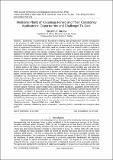| dc.description.abstract | Biodiversity is fundamental and foundation to offering plant germplasmfor scientific investigations
in the provision of useful biodata and biomedical data, both to benefit the flora and fauna. Studies were
undertaken in the Kakamega forest, rich in diverse species of immense and unmeasurable resource at different
levels of applications, for instance, alternative medicine provision and novel research studies in medicine to
configure active biomedical potency of the plant species for disease and pests management.However,
observations indicate urgent and remedial proactive measures should be put in place to attain the prime
objective of the alternative medicine studies. These include but not limited to, protect and conserve the current
biodiversity, provide relevant biomedical and floristic biodata (both at regional and national levels) though the
creation of botanical gardens with valid and prospective specifications for posterity measures like the
conventional and non-conventional models designed along the Indian approach models of testing the efficacy of
the drug after processing, whether in pure or crude form to ensure its vitality. Due to less attention drawn to the
assessment of plant diversity in the reserve Kakamega forest and its environ studies were initiated to add value
to similar studies in the Indian Himalayan Region (IHR), India.Simple random sampling was used where the
Questionnaire was administered to the traditional medical practitioners. Over two hundred and fifty plant
species of economic importance, belonging to 71 families and 90 genera have been reported. Among the useful
species, several species had multiple uses and rarely a species had single utility. The species included rareendangered e.g. Clerodendrum myricoides, Terminalia brownie, Warbugia salutaris, Bixia orellana (Rare);
Croton macrostachyus, Dioscorea alata (Vulnerable, 15 species). These and other species were categorized as
critically Endangered (15 spp.); andEndangered (25 spp.), following criteria of the International Union for
Conservation of Nature and Natural Resources (IUCN).During the studies, limitations abound the processing
phase were observed in several ways. These included lack of infrastructure both in terms of personnel and
research capacity, financial support-related items, patent-related regulations, availability and the high cost of
the equipment, maintenance of the equipment, lack of technical staff, preparedness to protect and use wisely the
biodiversity, procedure of processing of the drug from plant species is time-consuming, tedious and very
expensive. Even basic research laboratories of international standards is hardly available; and policies for
adopting alternative medicine are in their primordial phases. Also, limitations arise from the approval for
manufacturing of the drug once potent compound is identified and confirmed. These limitations notwithstanding,
the processed ‘medicinal’ material finds its way onto the market for disease management, for example, the
‘Makini herbal clinic’, ‘Murugu herbal clinic’ in east Africa. | en_US |

